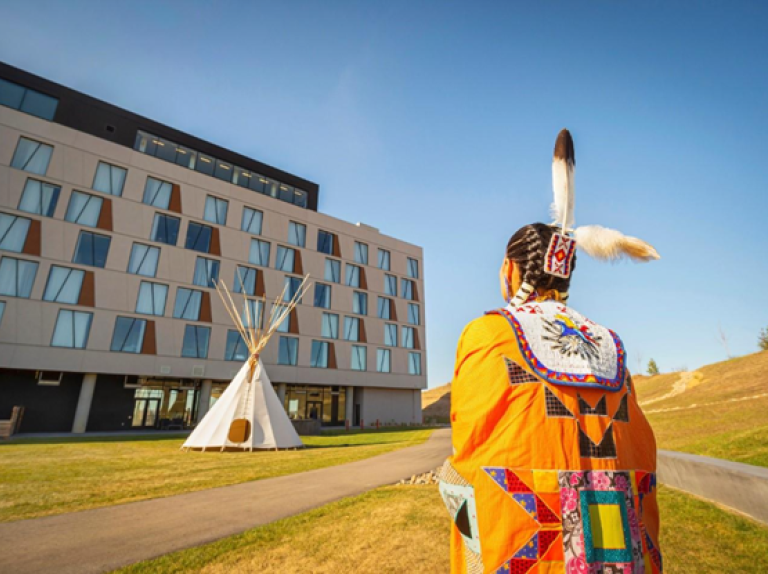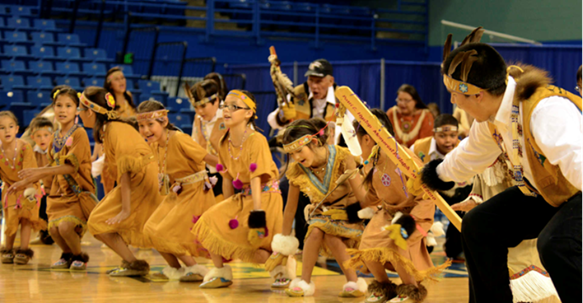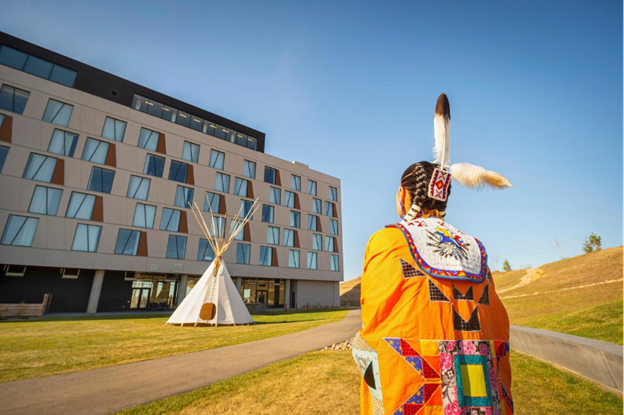
Indigenous tourism is increasingly recognized as a high-potential niche within the global travel market. Destination organizations have the opportunity to elevate it as a driver of cultural preservation, revitalization, and the sharing of traditional knowledge, practices, and languages. By uplifting these Indigenous voices, destinations help to foster meaningful economic vitality.
A recent report from the World Travel & Tourism Council projects that Indigenous-led tourism will generate more than $67 billion for the global economy by 2034. The report highlights tourism’s role in driving economic growth, particularly in remote regions, while also underscoring its vital contribution to cultural preservation and community empowerment. This presents a unique opportunity for destination organizations to position Indigenous tourism as a vital pillar of development, driving inclusive economic growth, cultural preservation, and authentic visitor experiences. In addition, there is an opportunity to help communities reclaim their identities, strengthen connections among different Indigenous nations, and identify new income sources, particularly in areas with limited opportunities.
A few organizations are leading the way in helping communities to share their authentic stories, including the Indigenous Tourism Association of Canada (ITAC) and the American Indigenous Tourism Association (AITA). ITAC is a global leader in the marketing and development of authentic Indigenous experiences across Canada. Recently, the Indigenous Tourism Association of Canada (ITAC) launched the Indigenous Tourism Destination Fund, creating an innovative opportunity for Indigenous and non-Indigenous businesses to collaborate in strengthening the tourism industry nationwide. Founded in 1998, AIANTA serves as a unique voice for the Indigenous tourism sector across the United States. The organization’s key priority is to provide technical training for Native communities across Alaska, Hawaii, and other American Indian Tribal nations to promote awareness of authentic cultural, heritage, and historic destinations.
Destination organizations in recent years have increasingly tapped into their Indigenous tourism potential across both the United States and Canada. The World Travel and Tourism Council estimates that the Indigenous tourism sector in Canada supports over 2,000 businesses, putting almost 40,000 Indigenous people to work across the country. The American Indian Alaska Native Tourism Association estimates that the Indigenous sector employs more than 210,000 people in the U.S., contributing more than $11 billion to the economy in 2025. Several destination organizations capitalizing on this momentum include Explore Fairbanks, Travel South Dakota, and Tourism Saskatchewan in the province of Saskatchewan, Canada. Each of these organizations highlights Indigenous tourism offerings as a commitment to authenticity, inclusivity, sustainability, and reconciliation, helping destinations thrive while ensuring that Indigenous communities benefit culturally, socially, and economically. Furthermore, there is growing interest among visitors in immersive, cultural, and accessible experiences that allow Indigenous stories to be shared in community-led ways, rather than appropriated.
Explore Fairbanks
On its website, Explore Fairbanks provides an array of opportunities to experience authentic Alaska Native culture, including visits to cultural centers, museums, exhibitions, dance, and drumming performances, and Indigenous art displays. Alaska is home to the modern Athabascan Indians from the Interior and Inupiat Eskimos of the Western Arctic Coast, who thrived without western amenities for hundreds of years. To honor these nations, Explore Fairbanks includes cultural activities and art of all kinds that are integral to Alaska Native people’s daily lives. Whether it's dancing, drumming, sports, or arts and crafts, these reflect authentic Alaska Native cultural events on display throughout the year. One of these events is the World Eskimo-Indian Olympics, which takes place in July each year. This energetic multi-day event features traditional games such as the Alaskan high kick, knuckle hop, and four-man carry, along with cultural dancing and authentic storytelling. Also, the Festival of the Native Arts, held every February, celebrates Alaska Native culture by showcasing a diverse array of performances from Indigenous peoples across the state.

Travel South Dakota
South Dakota is home to various nations of Indigenous people who have a deep connection to both their culture and the land. The Oceti Sakowin, also known as the Seven Council Fires, comprises the Lakota, Nakota, and Dakota tribal communities, primarily across present-day South Dakota, North Dakota, Minnesota, Montana, and Nebraska. Each subgroup has its own dialects, traditions, and stories, but all share the broader Sioux cultural framework. Travel South Dakota, the destination organization for the State of South Dakota, offers visitors a range of opportunities to engage with Indigenous tourism experiences that foster a space of learning, respect, reciprocity, and cultural preservation. One such offering is the Native American National and State Scenic Byway, which follows the Missouri River through the heart of South Dakota, guiding visitors across the lands of the Yankton, Crow Creek, Lower Brule, Cheyenne River, and Standing Rock Sioux Tribes. Along the route, visitors can view the Dignity Statue, a powerful tribute to the courage, perseverance, and wisdom of the Lakota people, symbolizing hope and promise for the future.
To further engage travelers along South Dakota’s tribal lands, Travel South Dakota has created the Tribal Nations: Oceti Sakowin Passport, a mobile travel passport that rewards travelers for visiting and checking in to gain points that can be redeemed for prizes. Additionally, Travel South Dakota produces a Guide to Tribal Nations – Oceti Sakowin Homelands. This print and digital travel guide focuses on the nine Tribal Nations within South Dakota. While Travel South Dakota produces the guide, the content is owned and sourced by the South Dakota Native Tourism Alliance. This partnership ensures that the content is authentic, relevant, accurate, and respectful. Included is a Visitors Etiquette Guide to visiting tribal lands, focused on adhering to conduct that is respectful of the tribes and their ceremonies.
Tourism Saskatchewan
Tourism Saskatchewan promotes the province as a tourism destination and assists industry in developing quality tourism products and experiences. Indigenous tourism is a strong and growing market, offering numerous experiences throughout the province.
Saskatchewan's Indigenous People and culture, from the Métis, Cree, Dakota, Nakota and Saulteaux in the south and central regions to Dene in the north, are celebrated across the province through cuisine, historic sites, museums, artists and more. Here you will meet storytellers who share their heritage through oral histories, art and traditions passed down through generations over thousands of years.
Several key Indigenous attractions and experiences are clustered within a short distance from the city of Saskatoon. Whitecap Dakota First Nation is home to the Dakota Dunes Resort, featuring the popular Dakota Dunes Casino and a hotel complex that reflects Indigenous heritage in its design and décor. Experiences include golfing the award-winning links-style course, guided stargazing showcasing Dakota sky stories, or learning how to set up a tipi, Dakota style. Dine at the Moose Woods Home Fire Grill, which has a farm-to-table menu.
Wanuskewin is a flagship attraction and the location of Canada’s longest-running archaeological dig site. Traces of human history, dating back 6,400 years, have been uncovered at this special place. The park features bison jumps, tipi rings and an ancient medicine wheel. Its resident Plains bison herd are descendants of the last 1,000 bison on the prairies before their near extinction in the 1870s. Wanuskewin is on the road to becoming a UNESCO World Heritage Site in 2028, a designation that will recognize the park’s role in protecting and preserving the land’s cultural heritage. Visitors can browse the gift shop, enjoy Indigenous-inspired cuisine, view contemporary and traditional art, walk the interpretive trails or book a guided tour.
On the lands of Beardy’s & Okemasis’ Cree Nation you will find Pêmiska Tourism. Translating to “come find it,” Pêmiska delivers an authentic connection to the land and its people through immersive activities, cultural education and outdoor adventure. Guided walking, biking, and ATV tours lead you to historic landmarks such as the site where Treaty 6 was signed, the grounds of the Battle of Duck Lake, and the storied Fort Carlton Provincial Historic Site. Experience overnight glamping accommodation in tipi-inspired lodges, take in cultural cuisine and performances, storytelling, and more. A 30-km (18.6-mi.) forested trail, part of the Trans Canada Trail, connects to historic Fort Carlton.

“Indigenous tourism experiences are a celebrated part of Saskatchewan’s tourism industry and an important part of the path to reconciliation,” Jonathan Potts, CEO, said. “Visitors to the province will be amazed at the range of quality, authentic experiences we have to offer.”
Summary
Once considered a niche market, Indigenous tourism has become a growing segment of the industry, with more destinations showcasing experiences that honor and amplify the voices of the communities whose stories and traditions shape the land. By creating authentic, Indigenous led experiences, destination organizations can not only preserve cultural heritage but also ensure that tourism growth in their communities is inclusive and respectful. Enhancing Indigenous tourism offerings creates meaningful economic opportunities for communities with limited resources, supports local businesses, and fosters long-term community well-being. Organizations such as Explore Fairbanks, Travel South Dakota, and Tourism Saskatchewan are pioneering a new path in Indigenous tourism, one designed to honor the culture and land of Indigenous peoples while fostering sustainable economic growth that ensures prosperity for future generations.
Submit Your Thought Leadership

Share your thought leadership with the Destinations International team! Learn how to submit a case study, blog or other piece of content to DI.


